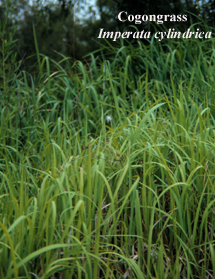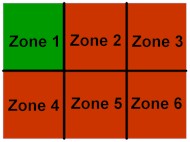Efforts to reclaim or restore CSAs are challenging given the fact that soil composition from these mined areas (heavy in phosphatic clays) is not the same "natural" soil type where native eco-systems evolved over thousands of years.
Resolving the technical and economic challenges of successful reclamation or restoration is especially significant given the fact that CSAs represent ~40% of all existing phosphate mining land in central Florida (~160,000 acres).
 Invasive Plants As a result of changed and disturbed soils from mining, many CSA sites have been invaded and are now dominated by numerous harmful
"non-native"
species trees and plants (also called "invasive exotics") -- the
most damaging being cogongrass, designated the worst perennial
grass weed of southern and eastern Asia and one of the 10 worst
weeds worldwide.
Invasive Plants As a result of changed and disturbed soils from mining, many CSA sites have been invaded and are now dominated by numerous harmful
"non-native"
species trees and plants (also called "invasive exotics") -- the
most damaging being cogongrass, designated the worst perennial
grass weed of southern and eastern Asia and one of the 10 worst
weeds worldwide.
Originally introduced in America unintentionally from Asian ships (at Southern U.S. Ports) and intentionally (for misguided forage and soil stabilization purposes)-- cogongrass
seed has been transported by the wind.
Once cogongrass has invaded and become established on a site, this weed aggressively spreads through it rhizomes (underground stems) -- producing more than three tons of rhizomes per acre!
The Weed From Hell: One reason cogongrass has such a damaging impact on native
eco-systems is that chemicals produced by this weed inhibit
growth of other plants. Called an allelopathic effect, this
allows cogongrass to dominate over native species trees and
plants affecting the total "native eco-system" including bard
sources for animal wildlife.
Environmental Background of Site: Prior to
site prep for tree planting, our current "energy crop plantation" in Lakeland was very typical of many CSAs --
dominated by cogongrass (up to 6 feet tall) and other highly
invasive and harmful exotics (Brazilian Pepper, Mimosa,
Chinaberry, Chinese Tallaw, Sesbania Rattlebox, Tropical Soda Apple).
Also, the site had a history of catastrophic wildfires (very
common on CSAs dominated by cogongrass) -- especially in the
winter months when cogongrass is extremely dry and highly flammable. According to the Florida Division of Forestry, cogongrass is a leading cause of wildfires in central Florida.
It should be noted that wildfires are actually beneficial in promoting new growth of cogongrass (rhizomes in the ground). In addition, cogongrass wildfires burn especially hot, usually killing any young native plants or trees that are trying to be established/compete in an infested area. Thus, through the combination of (1) the allelopathic effect and (2) the high temperatures of frequent wildfires from cogongrass, "sterile" prairies for native habitats have been created as the result of phosphate mining.
Importance of CSA Soil Remediation (Soil Building): In discussing soils we need to be very clear. We are not stating that CSA Soils are infertile. Field results where eucalyptus trees are achieving growth rates of ~20 feet per year clearly dispels a commonly held fallacy that CSAs are "worthless sites". We are saying that as a result of mining and invasive plants such as cogongrass, CSA Soils are compacted, lack organics, are nitrogen deficient, and have a high pH (~8).
| "the mining process causes severe changes in the landscape, particularly soils, and ground and surface water hydrology. Soils provide the substrate for [native plants] to establish themselves and to flourish . . . and thus restore ecosystem integrity." University of Florida/IFAS Paper. |
Such soil conditions are (1) clearly not conducive to native tree and flora establishment and development; (2) and for agriculture applications, reduce crop yields. The key for unlocking the full potential of CSAs centers on building soil organics.
 In Global Warming Research at our Tree Farm (e.g., the impact of creating carbon sinks with energy crops), one-year-old whole eucalyptus trees were excavated using a back-hoe. The above ground and below ground (e.g., the root systems) mass of the trees were then weighed.
Results showed whole tree weights of ~100 pounds -- of which, 38 pounds were in the tree's root system.
In Global Warming Research at our Tree Farm (e.g., the impact of creating carbon sinks with energy crops), one-year-old whole eucalyptus trees were excavated using a back-hoe. The above ground and below ground (e.g., the root systems) mass of the trees were then weighed.
Results showed whole tree weights of ~100 pounds -- of which, 38 pounds were in the tree's root system.
By introducing large volumes of organic matter through the tree's root system into the heavy clays, the following soil building attributes are being achieved:
Increasing Soil Organics and Microbial Activity.
Decreasing Soil Compaction/Bulk Density.
Decreasing Soil pH (from 7.8 to 6.8).
Increasing Available Nitrogen to Plants (C/N Ratio).
In addition, the energy crop trees are performing needed de-watering of the CSA Site through evaporation and transpiration of the trees.
An Innovative Approach to Native Species Reforestation:
From field research, three key aspects of fast growing energy crop trees and
cogongrass have been identified:
First, cogongrass can be effectively controlled for about 1 year by a one-time application
of herbicides and through soil disking; Second, energy crop
trees grow very quickly (achieving growth rates of up to ~20 feet
in one year) -- forming a dense tree canopy which reduces direct
sunlight to the forest floor; Third, cogongrass needs direct
sunlight to proliferate.
As previously discussed, energy crop trees have the ability to
coppice (re-grow from the stump) after harvesting. However, the ability to coppice productively will be between 6 and 8 harvests. Thus used in an agricultural application, assuming a harvest cycle of every 3
years -- trees in an energy crop plantation would have a useful
agriculture life of 18-24 years.
Our 4 Step Plan For Native Reforestation On Mined Land:
Herbicide cogongrass, disk, and create tree beds.
Plant fast growing energy crop trees (eucalyptus, cottonwoods)
After ~ 1 year (when the trees have shaded the ground), introduce native species plants on the forest floor.
This last step is critical in order to stabilize the forest floor. In coppice research we've performed at the plantation, we have seen that cogongrass that we though was controlled by the shade of ~20 bart trees -- came back with a vengeance once the trees were cut (allowing full sunlight to again reach the ground).
With each harvest of energy crop trees, we will "retire" a portion of the plantation by hand planting (so not to re-disturb the dormant cogongrass rhizomes still present in the soils) on the stabilized floor with native species trees.
| The key concept is that after the productive life of the Site as an energy crop plantation, the Site would be completely reforested with 100% native trees and plants.
|
Research on Stabilizing the Forest Floor with Native Plants: We are working with the University of Florida/IFAS to introduce "test plots" of native Florida plants and grasses on the energy crop's forest floor. However, as we approach this research work, it is worth noting that the native plant Commelina diffusa (creeping dayflower) is already rapidly spreading on the forest floor -- without any initiative on our part. According to the Florida Native Plants Webpage, the unopened flower buds, flowers, tender leaves, and seeds of creeping dayflower are eaten by game birds (quail, doves) and songbirds.
Project Advisors (Cargill, Florida Department of Environmental Protections, and the Natives Nursery) have provided the following list of native plants and grasses that will comprise our "test plots" on and between tree beds:
Lizard's tail, Saururus cernuus
Pennywort, Hydrocotyle sp.
Muhly grass, Muhlenbergia capillaris
Wiregrass, Aristida berhychiana
Chapman's Goldenrod
Beakrush, Rhynchospora sp.
Cord grass, Spartina sp.
Panicum anceps
Panicum longifolium
Eastern gamagrass Tripsacum dactyloides
Maidencane Panicum haemotomen
Short-topped goldenrod Euthamia minor
Aster elliotii
Goldenrod Solidago fistulosa
Winged Shumac Rhus copallina
Blackberry Rubus arbutifolia
Andropogon spp.
Illustrating the concept of Planned Retirement: For example -- if our energy crop trees had the ability to coppice 6 times (with productive yields), this would mean that we could have 6 harvests. At each harvest, we would "retire" a portion of the plantation replacing energy crop trees with a variety of native trees (but on a forest floor stabilized from cogongrass with native plants and grasses).
The following graphic illustrates this concept of planned retirement for an energy crop plantation. According to UF/IFAS Scientists, our energy crop trees will coppice (re-grow) only if harvested in cooler weather months in the fall or winter. Thus, referencing the below graphic, our first harvest in Zone 1 would be performed in warm weather months. As an alternative, we could herbicide the energy crop trees if any re-growth/coppice occurred after harvesting.





 Invasive Plants As a result of changed and disturbed soils from mining, many CSA sites have been invaded and are now dominated by numerous harmful
"non-native"
species trees and plants (also called "invasive exotics") -- the
most damaging being
Invasive Plants As a result of changed and disturbed soils from mining, many CSA sites have been invaded and are now dominated by numerous harmful
"non-native"
species trees and plants (also called "invasive exotics") -- the
most damaging being  In Global Warming Research at our Tree Farm (e.g., the impact of creating carbon sinks with energy crops), one-year-old whole eucalyptus trees were excavated using a back-hoe. The above ground and below ground (e.g., the root systems) mass of the trees were then weighed.
Results showed whole tree weights of ~100 pounds -- of which, 38 pounds were in the tree's root system.
In Global Warming Research at our Tree Farm (e.g., the impact of creating carbon sinks with energy crops), one-year-old whole eucalyptus trees were excavated using a back-hoe. The above ground and below ground (e.g., the root systems) mass of the trees were then weighed.
Results showed whole tree weights of ~100 pounds -- of which, 38 pounds were in the tree's root system.



